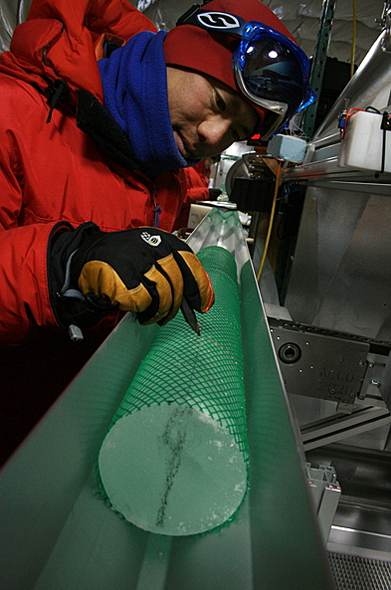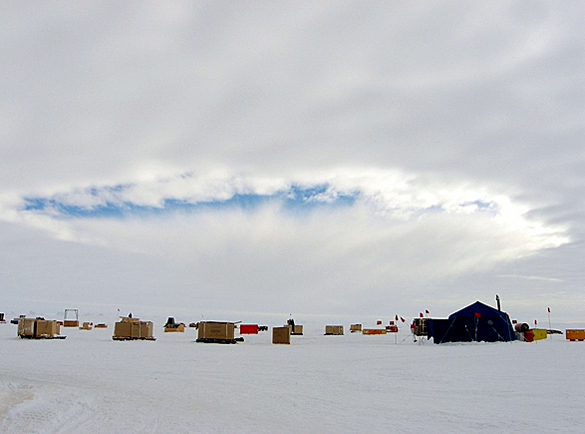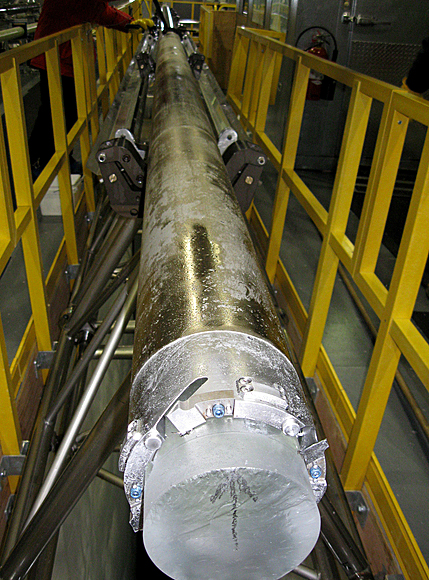Core truthsWAIS Divide ice records past environmental changes with implications for the futurePosted August 20, 2010
Twenty years ago, Kendrick Taylor Ten years ago, he wrote the science plan for the WAIS Divide Ice Core “And now we’re halfway through the ice sheet 10 years later after finding the perfect spot to take an ice core, building a highly advanced drill, and constructing a camp to support the work,” said Taylor, ruefully shaking his head, during an interview at the National Ice Core Laboratory (NICL) “I’ll feel really good when we get to the bottom and can fully focus on to the next phase — cranking through the data,” added Taylor, a research scientist at the Desert Research Institute Ice cores contain a wealth of information about regional and global climate, from the bubbles of gas trapped in the ice to microscopic particles of dust and perhaps even bits of biological material. From ice cores, scientists have been able to draw a correlation between carbon dioxide and other greenhouse gas concentrations in the atmosphere with the rise and fall of temperature. The WAIS Divide ice core is particularly special because of the high-resolution climatic and atmospheric record Taylor and others believe exists in the first 40,000 years of history contained in the ice. The final 3,330-meter-long core is expected to yield a climate record covering about 100,000 years — the entirety of the last glacial period when atmospheric carbon dioxide levels were much lower than they are today. [See previous article: Deep into WAIS Divide.] “The project is not studying Antarctica; it just happens WAIS Divide is the best place on the planet to get a record of how greenhouse gases have influenced climate over the last 100,000 years,” Taylor said. “It is like going to a library, but this library is cold, and makes it difficult to read the books that contain the old climate records.” The upcoming 2010-11 field season in Antarctica is scheduled to be the last for the deep-coring phase of the project. Last year, the team reached a depth of 2,564 meters using the Deep Ice Sheet Coring (DISC) drill Taylor said to reach this year’s goal, about 100 meters above where the ice meets bedrock, everything must fall into place. “The schedule is really tight. We will stop before we reach the bottom of ice, because we don’t want to contaminate the thin water layer that is under the ice and which has never been exposed to the rest of the planet,” he said. 
Photo Credit: WAIS Divide
Tractors buried in snow after sitting at the WAIS Divide field camp over the winter.
The main menace is weather. What makes the WAIS Divide site so appealing — lots of snow every year, which produces thick annual layers of climate history — also makes it a notoriously difficult place to reach. “It’s exciting and frustrating to work on the project,” said Mark Twickler, manager of the WAIS Divide Science Coordination Office (SCO), based at the University of New Hampshire The scientists and engineers in the project have been able to control to a large extent the quality of the core that’s emerged from the borehole once they reach the field camp. That was especially significant two years ago when the drill team hit a zone of about 700 meters of so-called brittle ice. The air bubbles in brittle ice are so compressed that pressure is intense enough to shatter the core once it reaches the surface. Using a technique first developed by the British Antarctic Survey 
Photo Credit: Anais Orsi/Scripps
Science technician Gifford Wong marks the azimuth of an ice core section encased in the green webbing that helped secure the brittle ice during the 2008-09 field season.
“That trick worked really well. We didn’t have any problems with the brittle ice,” Taylor said. “It was pretty easy to work with, and we’re going to be able to get good records out of it because it was in such good shape.” Added Logan Mitchell That’s a stark change to how the brittle ice emerged from a related but different ice-coring project in Antarctica at Siple Dome more than 10 years ago when the cores shattered and cracked. “A lot of It came out looking like ice cubes,” Taylor recalled. Taylor credits not only the green netting but also improvements in drilling technology and technique with the success on the WAIS Divide brittle ice. For instance, the drill is able to cleanly fracture the core into convenient 1-meter-long lengths while under high pressure deep in the hole. The old method used a saw on the surface that would shatter the brittle ice. In addition, the room temperature where the core comes to the surface is kept at a chilling minus 25 degrees Celsius. “It was so cold that people would go outside, to the middle of Antarctica, to warm up. That minimized the thermal shock to the ice, but maximized the thermal shock on the field staff,” Taylor said.1 2 Next |



For USAP Participants |
For The Public |
For Researchers and EducatorsContact UsU.S. National Science FoundationOffice of Polar Programs Geosciences Directorate 2415 Eisenhower Avenue, Suite W7100 Alexandria, VA 22314 Sign up for the NSF Office of Polar Programs newsletter and events. Feedback Form |



